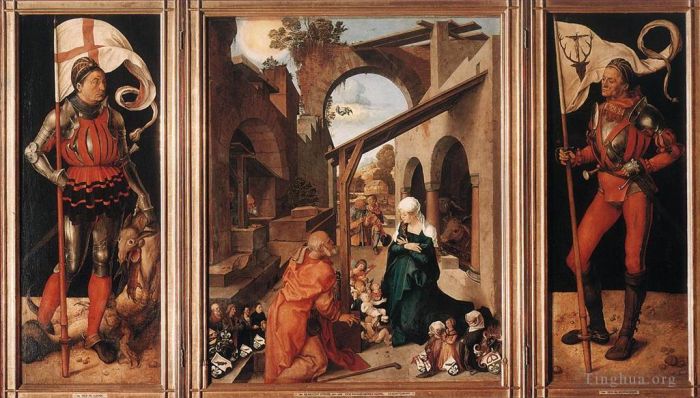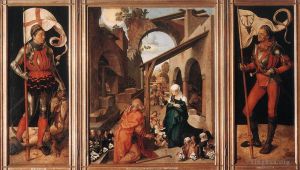Paumgartner altarpiece
Albrecht Durer
- Price: Price on Request
- Art Type: Oil Painting
- Size:
- English Comments: 0
- International Comments: 0
- Creating Date:
- Introduction and Works of Albrecht Durer >>
Keywords:
Paumgartner, altarpiece
Work Overview
- Paumgartner altarpiece
Albrecht Durer
Date: c.1503
Style: Northern Renaissance
Genre: religious painting
Media: oil, ink, panel
Dimensions: 157 cm × 248 cm
Location: Alte Pinakothek, Munich
The Paumgartner altarpiece (c. 1500) is an early triptych painting by Albrecht Dürer, commissioned by the Paumgartner family of Nuremberg. The central panel depicts a nativity scene, while the wings depict Saint George (left) and Saint Eustace (right). The saint's faces are donor portraits of the brothers Stephan and Lukas Paumgartner, respectively. Other members of the Paumgartner family are depicted as small figures in the center panel.
In 1616 the painting was bought by Maximilian I, Elector of Bavaria and taken to Munich. There it was altered to suit 17th century tastes. This entailed adding helmets, horses, and landscape backgrounds to the portraits of the saints and painting over the small donor figures in the center panel. These embellishments were removed by restorators in 1903.[1][2]
On 20 April 1988, the Paumgartner altarpiece was one of three paintings at the Alte Pinakothek that were attacked with concentrated sulfuric acid by the serial art vandal Hans-Joachim Bohlmann.[3] It alone suffered at least $12 million worth of damage.[4] After 21 years of restoration, it was returned to display in 2010.
The altar has the traditional shape of a winged altarpiece. The outside, the weekday side, displays a workshop production of an Annunciation and the former standing figures of saints Catherine and Barbara. When opened, the magnificent colours of the Nativity are visible, framed by saints George and Eustace.
This triptych was commissioned by the brothers Stephan and Lukas Paumgartner for St Catherine's Church in Nuremberg. It may well have been ordered after Stephan's safe return from a pilgrimage to Jerusalem in 1498. The main panel depicts the Nativity, set in an architectural ruin. The left wing shows St George with a fearsome dragon and the right wing St Eustace, with both saints dressed as knights and holding identifying banners. A seventeenth-century manuscript records that the side panels were painted in 1498 and that the two saints were given the features of the Paumgartner brothers (with Stephan on the left and Lukas on the right). This is the earliest occasion on which an artist is known to have used the facial features of a donor in depicting a saint. The exteriors of the wing panels were of the Annunciation, although only the figure of the Virgin on the left panel has survived.
On stylistic grounds, the Nativity was painted a few years later than the wings, probably in 1502 or soon afterwards. The tiny body of Christ is almost lost in the composition, surrounded by a swarm of little angels. Peering out from behind the Romanesque columns on the right are the ox and the ass, while opposite them on the left side are the faces of two shepherds. The composition, formed by the ruins of a palatial building, draws the eye towards the archway. Two other shepherds step up into the courtyard, the red and blue of their clothes echoing the colours of Joseph and the Virgin Mary. In the sky, an angel descends to reveal news of Christ's birth to another pair of shepherds tending their flock on the distant hillside. Although traditionally a night-time scene, it is brightly illuminated by a ball of light in the sky.
The small figures at the bottom corners of the central panel are the Paumgartner family with their coats of arms. They were painted over in the seventeenth century, when donor portraits went out of favour, and were only uncovered during restoration in 1903. On the left behind Joseph are the male members of the family, Martin Paumgartner, followed by his two sons Lukas and Stephan and an elderly bearded figure who may be Hans Schönbach, second husband of Barbara Paumgartner. On the far right is Barbara Paumgartner (née Volckamer), with her daughters Maria and Barbara.
In 1988 this painting was seriously damaged by a vandal, along with the Lamentation for Christ and the central panel of The Seven Sorrows of the Virgin depicting the grieving Mary. Restoration of the Paumgartner Altarpiece and the Lamentation for Christ was completed in 1998 and work then began on the panel of the Virgin.
The side wings depict St George on the left and St Eustace on the right, complete with their attributes on their banners as recorded in the Legenda aurea. St George was a crusader and had liberated the Libyan town of Silena from the dragon, while the Crucified Christ had appeared to St Eustace in a forest in the antlers of a stag, thus converting him to Christianity. The donors themselves appear in the form of their personal saints. On the left, facing the central panel, Stephan Paumgartner appears as St George, and on the right Lukas Paumgartner appears as St Eustace. Both are wearing splendid knightly armor. They are Christian knights, guards and protectors of the holy shrine, the Nativity of Christ in the central panel where they appear once more as part of the group of the donating family.
- Copyright Statement:
All the reproduction of any forms about this work unauthorized by Singing Palette including images, texts and so on will be deemed to be violating the Copyright Laws.
To cite this webpage, please link back here.
- >> English Comments
- >> Chinese Comments
- >> French Comments
- >> German Comments
- >>Report
- Emperor Charlemagne
- Virgin Suckling the Child
- Emperor Charlemagne and Emperor Sigismund
- The Apostles Philip and James
- The Cross
- Salvator Mundi
- The Dresden Altarpiece
- St Peter
- Portrait of Emperor Maximilian I
- Alliance Coat of Arms of the Durer and Holper Families
- Portrait of Jacob muffle
- Saint Jerome (St Jerome in the Wilderness)
- Paumgartner Altar right wing
- Portrait of St Sebastian with an Arrow
- Portrait of a Boy with a Long Beard
- Adam and Eve
- The Jabach Altarpiece
- Suicide of Lucretia
- The Seven Sorrows of the Virgin
- Portrait of Oswolt Krel full
- Self-Portrait (Portrait of the Artist Holding a Thistle)
- Four Apostles
- Portrait of a Young Man
- Lots escape
- Portrait of a Man 1504
- Portrait of Hieronymus Holzschuher
- St Jerome
- Twelve year old Jesus in the Temple
- Circumcision of Jesus (Seven Sorrows The Circumcision)
- John
- Christ as the Man of Sorrows
- Holy Family
- The Dresden Altarpiece central panel
- Christ among the Doctors
- Sylvan Men with Heraldic Shields Albrecht Durer
- Job and His Wife
- Maria with child
- The Four Apostles left part St John and St Peter
- The Seven Sorrows of the Virgin The Flight into Egypt
- Portrait of Elector Frederick the Wise of Saxony
- Paumgartner Altar left wing
- Portrait of Elsbeth Tucher
- The Virgin Mary in Prayer
- Ecce Homo
- Portrait of Barbara Durer
- The Madonna of the Carnation
- Portrait of a Young Furleger with Her Hair Done Up
- Combined Coat of Arms of the Tucher and Rieter Families
- Paumgartner altarpiece
- Portrait of a Young Furleger with Loose Hair
- Adoration of the Trinity (Landauer Altarpiece)
- Portrait of Durers Father at 70
- Portrait of a Man 2
- Two Musicians
- The Seven Sorrows of the Virgin Mother of Sorrows
- Portrait of a Young Venetian Woman
- Felicitas Tucher nee Rieter
- Albrecht Portrait of a Man
- Self-Portrait (Self-Portrait with Fur-Trimmed Robe)
- Virgin and Child before an Archway
- Madonna and Child Haller Madonna
- Virgin and child holding a half eaten pear
- The Dresden Altarpiece side wings
- Lot and His Daughters (Lot Fleeing with his Daughters from Sodom)
- Madonna with the Siskin
- Drummers and pipers
- Self-Portrait at 26
- Face a young girl with red beret
- Hans Tucher
- The flight to Egypt Softwood
- Lamentation of Christ
- Hercules kills the Symphalic Bird
- Portrait of the Elder
- Seven Sorrows Crucifixion
- Eve Renaissance
- Avarice
- Virgin and Child with Saint Anne
- Adoration of the Magi
- Martyrdom of the Ten Thousand
- The Lady of the festival du Rosaire
- Emperor Sigismund
- Sylvan Men with Heraldic Shields
- Portrait of Oswolt Krel
- Lamentation for Christ
- The Wire-Drawing Mill
- Primula
- The tuft of grass MINOR
- Garza
- The Little Owl
- Crucifixion
- Cervus Lucanus
- View of Nuremberg
- Lobster
- The Holy Family in a Trellis
- Nuremberg Woman Dressed for Church
- The Castle at Trento
- Innsbruck
- House by a Pond
- Head of an Angel
- Courtyard of the Former Castle in Innsbruck with Clouds
- Lion
- Iris
- Hands
- Hand
- Cupid the Honey Thief
- Self portrait at 13
- View of the Arco Valley in the Tyrol
- Head of a Stag
- The Trefileria on Peignitz
- Arion 2
- Arion
- Knight On Horseback
- A Young Hare
- The Trefileria on Peignitz 2
- Pond in the wood
- Dry dock at Hallerturlein Nuremberg
- Willow Mill
- The Prodigal Son
- View of Kalchreut
- Saint John Church
- Iris Troiana
- The Fall
- Doss Trento
- Innsbruck Seen from the North
- Hare
- Tilo on the cantilever of a bastion
- Courtyard of the Former Castle in Innsbruck without Clouds
- Dead Bluebird
- Map of the Southern Sky
- The city of Trento
- Three Mighty Ladies from Livonia









 Singing Palette
Singing Palette